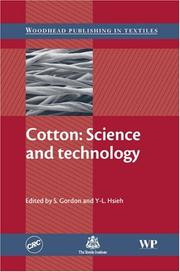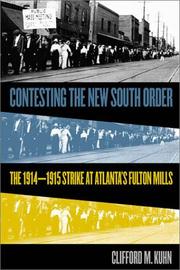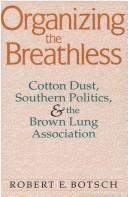| Listing 11 - 20 of 20 | << page >> |
Sort by
|

ISBN: 0871691892 9780871691897 Year: 1990 Volume: 189 Publisher: Philadelphia (Pa.): American philosophical society
Abstract | Keywords | Export | Availability | Bookmark
 Loading...
Loading...Choose an application
- Reference Manager
- EndNote
- RefWorks (Direct export to RefWorks)
Cotton manufacture --- Power supply --- Costs. --- -Cotton manufacture --- -Cotton mills --- Textile industry --- -Costs --- -Power supply --- Cotton mills --- Power supply&delete& --- Costs --- Cotton manufacture - United States. --- Cotton manufacture - United States - Power supply - Costs.
Book
ISBN: 9798890869869 0807861464 Year: 1992 Publisher: Chapel Hill : University of North Carolina Press,
Abstract | Keywords | Export | Availability | Bookmark
 Loading...
Loading...Choose an application
- Reference Manager
- EndNote
- RefWorks (Direct export to RefWorks)
Built by local entrepreneurs during Dixie's post-Civil War textile boom, the Crown Cotton Mill in Dalton, Georgia, acted as a magnet for thousands of newly impoverished white farm families who moved to the factory and its company-owned village from the surrounding countryside. In Creating the Modern South, Douglas Flamming examines one hundred years in the life of the mill and the town, providing a uniquely perceptive view of Dixie's social and economic transformation. With a sophisticated blend of statistical analysis, oral history interviews, and a variety of such traditional sources as company records, federal census schedules, and local newspapers, Flamming weaves an empirically convincing, richly embroidered description of life in a southern cotton-mill village. Whereas some historians have characterized southern textile workers as slaves in an "industrial plantation" system, and others have described the creation of an autonomous culture of opposition to management, Flamming focuses on the intimate, ever-changing, and potentially explosive relationship between millhands and managers, effectively demonstrating that both groups acted as architects of the emerging industrial order. The Crown Mill story addresses important issues of social change faced by the modernizing South: the origins of small-town industry, worker migration from farm to factory, and the rise of an industrial elite; the adaptation of rural customs to an industrial environment and the development of a working-class culture; the advent of mill-village paternalism and the dilemmas of unionization; the impact of World War II on southern life; the collapse of paternalism and the antilabor backlash of the 1950s; and the decline of Dixie's cotton mills in the burgeoning Sunbelt economy. Ultimately, the history of the Crown Mill community both underscores the human dimensions of industrialization and places the New South in the broader context of an industrialized America.
Cotton textile industry --- Industries --- History. --- Case studies. --- History --- Crown Cotton Mills Co. (Dalton, Ga.) --- Crown Cotton Mills Co. (Dalton, Whitfield County, Ga.) --- Dalton (Ga.) --- Dalton (Whitfield County, Ga.) --- Economic conditions.

ISBN: 9780759104228 0759104220 0759104212 9780759104211 Year: 2006 Publisher: Lanham Altamira
Abstract | Keywords | Export | Availability | Bookmark
 Loading...
Loading...Choose an application
- Reference Manager
- EndNote
- RefWorks (Direct export to RefWorks)
Cotton manufacture --- Cotton fabrics --- Coton --- Tissus de coton --- History. --- Industrie --- Histoire --- Cotton mills --- Textile industry --- Cotton textiles --- Textile fabrics --- History
Book
ISBN: 275740766X 2757414283 2757408003 9782757407660 Year: 2016 Publisher: Villeneuve d'Ascq : Presses universitaires du Septentrion,
Abstract | Keywords | Export | Availability | Bookmark
 Loading...
Loading...Choose an application
- Reference Manager
- EndNote
- RefWorks (Direct export to RefWorks)
Le « roi coton » joue sans conteste un rôle majeur lors de la première Révolution industrielle. Et dans le Nord de la France, nombreux ont été ceux qui, un siècle et demi durant, ont entrepris de filer, de tisser ou d'imprimer des toiles. Dans ce territoire frontalier de longue tradition textile, le travail de la fibre se greffe là où régnaient en maîtres la laine et le lin. Partant d’une analyse fine de l’attente des consommateurs, Mohamed Kasdi montre comment cette activité s’immisce très tôt dans le travail manufacturier, tant à la ville qu’à la campagne. Produits innovants, changements technologiques, prise de risques financiers, conquête des marchés : dans une économie régionale qui, au fil du xviiie siècle, s’essouffle progressivement, le coton impulse une dynamique renouvelée. Quand surviennent les bouleversements révolutionnaires, ni le dérèglement des circuits commerciaux ni les incertitudes du lendemain ne constituent des freins. Au contraire : nombreux sont ceux qui, fort possessionnés ou gens de peu, prennent des initiatives permettant toutes, à des échelles diverses, de moderniser l’appareil productif. L’Empire, quant à lui, confirme ce qui était en gestation tout en passant au tamis de la conjoncture le bon grain et l’ivraie. Dès lors, seuls, ou presque, survivent ceux qui disposent d’assises solides. Au cours des premières décennies du xixe siècle, mécanisation et concentration de la main-d’œuvre achèvent la mue du secteur. De grandes dynasties du négoce régional font alors du coton le fer de lance de leur prospérité, modifiant durablement la carte productive : sortant de l’ombre portée de Lille, Roubaix et Tourcoing prennent leur essor en faisant du coton un produit phare.
Cotton trade --- Cotton manufacture --- History --- Cotton mills --- Textile industry --- Histoire économique et sociale --- XVIIIe s.-1830, 1701-1830 --- Coton --- Exploitation économique --- Commerce --- France septentrionale --- coton --- industrialisation --- entrepreneur

ISBN: 1845692489 1845690265 9781845692483 9781845690267 Year: 2007 Publisher: Cambridge, England ; Boca Raton, Florida : Woodhead Publishing Limited,
Abstract | Keywords | Export | Availability | Bookmark
 Loading...
Loading...Choose an application
- Reference Manager
- EndNote
- RefWorks (Direct export to RefWorks)
Despite the increased variety of manufactured fibres available to the textile industry, demand for cotton remains high because of its suitability on the basis of price, quality and comfort across a wide range of textile products. Cotton producing nations are also embracing sustainable production practices to meet growing consumer demand for sustainable resource production. This important book provides a comprehensive analysis of the key scientific and technological advances that ensure the quality of cotton is maintained from the field to fabric.The first part of the book discusses the
Cotton growing. --- Cotton manufacture. --- Cotton. --- American upland cotton --- Gossypium --- Gossypium hirsutum --- Gossypium mexicanum --- Hairy cotton --- Seed cotton --- Thurberia --- Upland cotton --- Malvaceae --- Plant fibers --- Cotton mills --- Textile industry

ISBN: 0807826448 0807849731 0807875309 9780807875308 9780807826447 9780807849736 9798890869227 Year: 2001 Publisher: Chapel Hill University of North Carolina Press
Abstract | Keywords | Export | Availability | Bookmark
 Loading...
Loading...Choose an application
- Reference Manager
- EndNote
- RefWorks (Direct export to RefWorks)
In May 1914, workers walked off their jobs at Atlanta's Fulton Bag and Cotton Mills, launching a lengthy strike that was at the heart of the American Federation of Labor's first major attempt to organize southern workers in over a decade. In its celebrity, the Fulton Mills strike was the regional contemporary of the well-known industrial conflicts in Lawrence, Massachusetts, and Ludlow, Colorado. Although ultimately unsuccessful, the strike was an important episode in the development of the New South, and as Clifford Kuhn demonstrates, its story sheds light on the industrialization, urbanizati
Fulton Bag and Cotton Mills Strike, Atlanta, Ga., 1914-1915. --- Industrial relations. --- Strikes and lockouts. --- Fulton Bag and Cotton Mills Strike, Atlanta, Ga., 1914-1915 --- Strikes and lockouts --- Industrial relations --- History. --- Cotton manufacture --- Combinations of labor --- Lockouts --- Work stoppages --- Capital and labor --- Employee-employer relations --- Employer-employee relations --- Labor and capital --- Labor-management relations --- Labor relations --- Direct action --- Labor disputes --- Strikebreakers --- Employees --- Management
Book
ISBN: 9783412515102 3412515108 Year: 2019 Publisher: Wien Böhlau Verlag
Abstract | Keywords | Export | Availability | Bookmark
 Loading...
Loading...Choose an application
- Reference Manager
- EndNote
- RefWorks (Direct export to RefWorks)
While cotton was a world-changing good in the early modern period, for producers, merchants, and consumers, it was but one of many different fabrics. This volume explores this dichotomy by contextualizing cotton within its contemporary culture of textiles. In doing, it focuses on a long, under-researched region: the German-speaking world, particularly Switzerland, which transformed into one of the most prolific European regions for the production of printed cottons in the eighteenth century. Sixteen contributions investigate the (globally entangled) history of Indiennes, silk, wool, and embroideries, giving new insights into the manufacturing, marketing, and consumption of textiles between 1500 and 1900.
History of Germany and Austria --- anno 1500-1799 --- anno 1800-1899 --- Textilwirtschaft. --- Geschichte 1500-1900. --- Deutsches Sprachgebiet. --- Schweiz. --- Cotton manufacture --- Cotton fabrics --- Cotton fabrics. --- Cotton manufacture. --- German-speaking Europe. --- Cotton mills --- Textile industry --- Cotton textiles --- Textile fabrics

ISBN: 9780813162188 0813162181 0813118182 9780813118185 0813151368 9780813151366 Year: 1993 Publisher: Lexington
Abstract | Keywords | Export | Availability | Bookmark
 Loading...
Loading...Choose an application
- Reference Manager
- EndNote
- RefWorks (Direct export to RefWorks)
In the 1970's, textile workers joined forces with a small band of grassroots activists and organizers and challenged the most powerful industrial interest in the heart of Dixie-the cotton textile manufacturers. They located disabled workers and organized them, employing the full range of interest- group tactics, and they creatively engaged in legislative, administrative, and judicial lobbying as well as protest actions-with remarkable success. Robert E. Botsch recounts the history of the Brown Lung Association and details the interaction of the major participants in the rise-and ultimately the...
Textile workers --- Cotton dust --- Byssinosis --- Cotton manufacture --- Textile industry --- Employees --- Dust --- Brown lung --- Lungs --- Cotton mills --- Health and hygiene --- Health aspects --- Social aspects --- Dust diseases --- Diseases --- Brown Lung Association --- Carolina Brown Lung Association --- History.

ISSN: 00694290 ISBN: 2713209684 9782713209680 Year: 1991 Volume: 83 Publisher: Paris École des hautes études en sciences sociales
Abstract | Keywords | Export | Availability | Bookmark
 Loading...
Loading...Choose an application
- Reference Manager
- EndNote
- RefWorks (Direct export to RefWorks)
History of France --- anno 1700-1799 --- anno 1800-1899 --- Cotton manufacture --- Cotton trade --- Coton --- History --- Industrie --- Histoire --- Commerce --- 677.21 --- -Cotton manufacture --- -Cotton trade --- -#SBIB:94H2 --- Textile industry --- Cotton mills --- Cotton --- -History --- -Geschiedenis van Frankrijk --- 677.21 Cotton --- #SBIB:94H2 --- Geschiedenis van Frankrijk --- France --- Cotton trade - France - History - 18th century. --- Cotton trade - France - History - 19th century. --- Cotton manufacture - France - History - 18th century. --- Cotton manufacture - France - History - 19th century. --- Textiles et tissus --- Industrie et commerce --- 18e-19e siecles --- 18e-20e siecles
Book
ISBN: 0841208824 Year: 1982 Publisher: Washington, District of Columbia : American Chemical Society,
Abstract | Keywords | Export | Availability | Bookmark
 Loading...
Loading...Choose an application
- Reference Manager
- EndNote
- RefWorks (Direct export to RefWorks)
Cotton manufacture --- Cotton dust --- Byssinosis --- Pneumoconiosis --- Particulate Matter --- Malvaceae --- Environmental Pollution --- Textiles --- Occupational Diseases --- Textile Industry --- Public Health --- Complex Mixtures --- Angiosperms --- Lung Diseases, Interstitial --- Lung Injury --- Lung Diseases --- Industry --- Chemicals and Drugs --- Diseases --- Environment and Public Health --- Embryophyta --- Health Care --- Respiratory Tract Diseases --- Streptophyta --- Technology, Industry, and Agriculture --- Technology, Industry, Agriculture --- Viridiplantae --- Plants --- Eukaryota --- Organisms --- Gossypium --- Cotton Fiber --- Dust --- Air Pollution --- Medicine --- Health & Biological Sciences --- Industrial Medicine --- Congresses --- Health aspects --- Dust control --- Plastiques (Matières). (Congrès) --- Plastiek. (Congres) --- Magnoliopsida --- Cotton mills --- Textile industry --- Brown lung --- Lungs --- Textile workers --- Dust diseases
| Listing 11 - 20 of 20 | << page >> |
Sort by
|

 Search
Search Feedback
Feedback About UniCat
About UniCat  Help
Help News
News